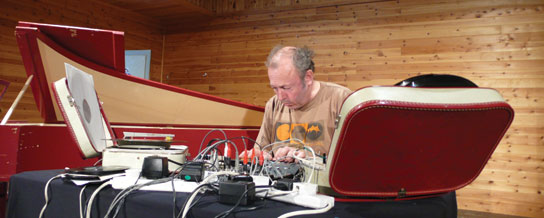Artist Tips: Philip Jeck
If you believe that “turntablism” is just a sexed-up word for DJs scratching records over […]

Artist Tips: Philip Jeck
If you believe that “turntablism” is just a sexed-up word for DJs scratching records over […]

If you believe that “turntablism” is just a sexed-up word for DJs scratching records over clichéd breakbeats, consider Philip Jeck. The British artist revives entombed moments from forgotten records and makes them surrealistic and ghostly under his touch. He prefers the natural decay of lo-fi turntables (employing 180 of them for his Vinyl Requiem performance), and from there he loops rich drones, disembodied vocals, and chords that arise like blown dust. His recent album, Sand (Touch), continues what he does best. Here, Jeck gives us a few tips on sampling and looping vinyl sounds.
Keep it simple
The methods I use are not that important to me in the making of the sound, but they are the simplest I have found. My biggest tip would be listen to what you are doing rather than looking, take away as much as you can, and still leave something interesting and/or emotionally engaging.
Use tape to form your loops
I put a little sticker on each record to make the stylus stay in one groove. (A tip from turntablist Christian Marclay.) I use a guitar delay pedal that will make loops of different lengths that can be added to without losing the original loop.
Experiment with speed
I have a large collection of old turntables from the 1950s, ’60s, and ’70s, which were originally collected for Vinyl Requiem. The ones I use for concerts are the two smallest and lightest I have (to cut down on weight and excess baggage charges). They have four speeds (16/33/45/78 rpm). I like to use the 16 rpm a lot. At that speed, the sound becomes its grainiest. These old players also distort the sounds in their own way and are not too reliable as far as speeds go, so they bring variations into the sound all the time. The records I use are of every different genre, and have on the whole been thrown (or given) away by someone.
Sample creatively
The Casio SK-1 keyboard, which is a simple lo-fi sampler–and is, unfortunately, not manufactured anymore–is what I use to make samples. I sample as I play, choosing which record to sample through the auxiliary outs on my mixer (which is a Behringer and has built-in effects, though I only use a handful of them). I love the sound of the SK-1. It always seems to distort in wonderful ways and it’s always a one-off, as you can’t save the sample.
Impose limits on yourself
In my playing, my intent is to find something that excites and moves me in some way. Then I try to expand it or reduce it to make a larger or more refined statement. I recommend limiting oneself (i.e. turn something off; do everything with one hand). Any limitation can take you somewhere you might not have gone otherwise. Also, when something comes into your mind to do, stop and wait for the next idea/action. In the end, the most important thing is the sound; all focus should be on that.

